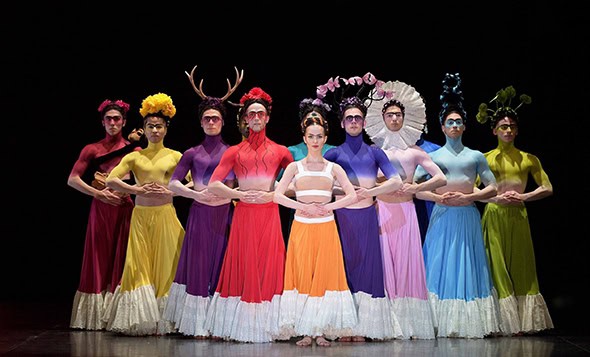English National Ballet, She Persisted
Posted: April 22nd, 2019 | Author: Nicholas Minns & Caterina Albano | Filed under: Performance | Tags: Alice Bellini, Angela Wood, Annabelle Lopez Ochoa, Antony Tudor, Emily Suzuki, English National Ballet, Erina Takahashi, Francisco Bosch, Henry Dowden, Irek Mukhamedov, James Forbat, Joseph Caley, Katja Khaniukova, Louie Whitemore, Pina Bausch, Rentaro Nakaaki, She Persisted, She Said, Stina Quagebeur, Trui Malten | Comments Off on English National Ballet, She PersistedEnglish National Ballet, She Persisted, Sadler’s Wells, April 12

The title of English National Ballet’s second program celebrating female choreographers, ‘She Persisted’, may have derived, as Sarah Crompton writes in the program, from a 2017 statement by US Senator Mitch McConnell, but it also neatly references the company’s first program from two years ago, She Said. One of those works reappears here — Annabelle Lopez Ochoa’s Broken Wings — alongside Pina Bausch’s Le Sacre du printemps (The Rite of Spring) that ENB acquired in 2016. Although the program only partially addresses the persistently unanswered question of why there are not more new female choreographers in classical ballet, the one new work by company dancer Stina Quagebeur, Nora (after the character in Henrik Ibsen’s The Doll House on which it is based), marks the arrival of a distinctive, independent voice.
It is immediately clear at the opening of Nora that Quagebeur has a choreographic imagination and the lighting of Trui Malten enhances it. Between them they introduce Nora (Erina Takahashi) engulfed in black walking though a door of light followed by five ‘voices’ (Alice Bellini, Angela Wood, James Forbat, Francisco Bosch and Rentaro Nakaaki) whose turbulent gestures form a constant expressionist chorus of Nora’s state of mind. Louie Whitemore’s isometric set with its tubular frame and suspended beams provides just enough volume to contain the storm of emotions the choreography unleashes. Quagebeur, however, hasn’t yet evolved a vocabulary that fully matches her imagination; the narrative tends to pull her in one direction and the pressure to devise steps in another. When Henry Dowden as the banker, Krogstad, first appears it’s easy to mistake him for Nora’s husband, Torvald, and she gives Joseph Caley as Torvald too much convoluted movement to arrive at a single expressive gesture. The subtlety and eloquence with which Antony Tudor pared back his choreography to transform narrative into gesture may serve as a useful guide for her next (much anticipated) work.
Broken Wings has not been repaired since its first outing three years ago. It has vivid colour and a rich score but it seems — in contrast to the lives portrayed — choreographically quite thin. Ideas like the gender-fluid array of men and the dancing skeletons are brilliantly conceived but outshine their narrative importance; Broken Wings is all about Frida Kahlo and yet she barely manages to emerge from her own story. The stage is dominated by Dieuweke van Reij’s mobile cube that serves as Kahlo’s home, hospital and tomb and its manipulation by the skeletons from one manifestation to the next interrupts rather than informs the narrative. Lopez-Ochoa has clearly built her choreography on the relationship between Khalo and Diego Rivera and although their intense love and fiery intellectual bond appears too much as the stereotype of boy meets girl, the impassioned performances of Katja Khaniukova and Irek Mukhamedov give the broken wings an opportunity to fly.
When it was announced that English National Ballet had obtained the rights to perform Pina Bausch’s Sacre du printemps it was a major coup, adding another level of prestige to the company’s profile under Tamara Rojo’s leadership. The challenges of performing the work at ENB, however, differ from those in Tanztheater Wuppertal; there the dancers are attuned to Bausch’s way of working whereas ENB’s broad repertory demands of its dancers a constant readjustment to its rigours. Bausch’s Sacre du printemps never was, nor can it ever be a trophy work. It marries savagery with lyricism to an extent the two qualities live within each other; there is no respite as one emerges from the other. Josephine Ann Endicott, who staged it for ENB, was one of the work’s original dancers. She describes the movements to Crompton as feeling ‘masculine and not pretty, but at other moments they are extremely soft, sensual and feminine. You run with your heart and forget all you have learnt before and just come out and be yourself. It has to be real. If you are not exhausted at the end, you haven’t danced it properly.’ This evening there are moments among the men — noticeably in the transitions to partnering the women — when this kind of commitment is missing, when the mechanics of performing a phrase get in the way of expressing it. The energy and focus of the women, however, continues to feed each other until Emily Suzuki takes on the mantle of the chosen one and pushes the limits of her endurance to a level of artistry the work demands.